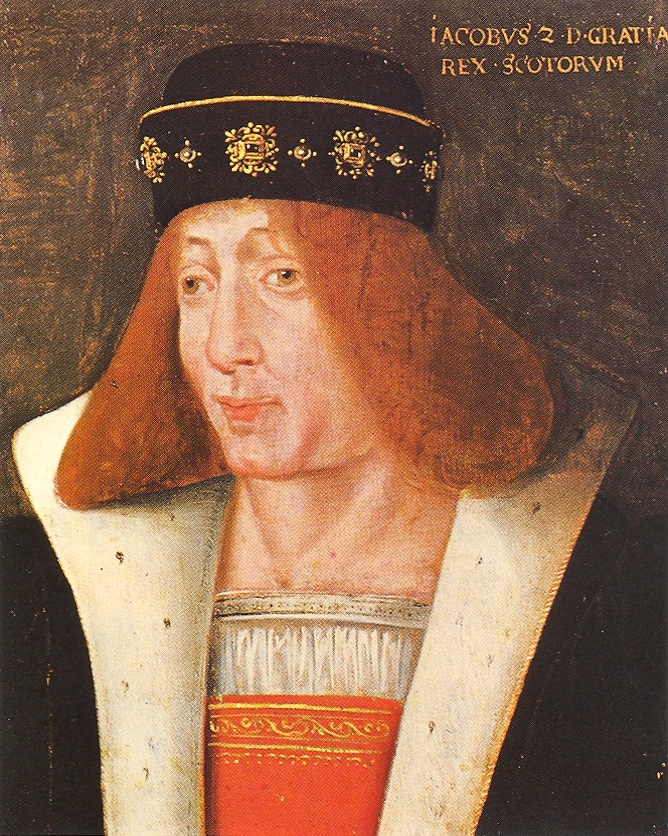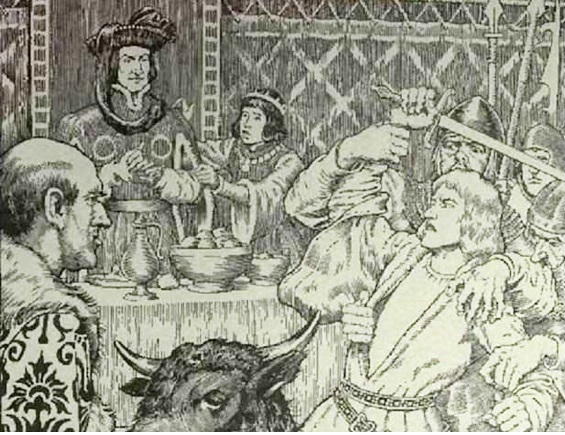by Susan Flantzer © Unofficial Royalty 2017

James II, King of Scots; Credit – Wikipedia
James II, King of Scots was born on October 16, 1430, at Holyrood Abbey in Edinburgh, Scotland. He had an elder twin brother named Alexander who died before his first birthday, making James the heir to the throne of Scotland and the holder of the titles Duke of Rothesay and Steward of Scotland. James was then the only son of James I, King of Scots and Lady Joan Beaufort, a granddaughter of John of Gaunt who was a son of King Edward III of England. James II had six sisters, three older and three younger. He was nicknamed “Fiery Face” because of a birthmark on his face.
James II had seven siblings:
- Margaret Stewart (1424 – 1445), married the future King Louis XI of France, she died before her husband became king, no issue
- Isabella Stewart (1426 – 1494/ – 1499), married François I, Duke of Brittany, had issue
- Joan Stewart (1428 – circa 1486), married James Douglas, 1st Earl of Morton, had issue
- Alexander Stewart, Duke of Rothesay (born 1430, died before his first birthday), elder twin of James II
- Eleanor Stewart (1433 – 1480), married Sigismund, Archduke of Austria, no surviving issue
- Mary Stewart, Countess of Buchan (1434/35 – 1465), married Wolfert VI of Borselen, no surviving issue
- Annabella Stewart (1436 – 1509), married (1) Louis of Savoy, Count of Geneva, marriage annulled, no issue (2) George Gordon, 2nd Earl of Huntly, marriage annulled, had issue
During the reign of James I, there were lingering doubts about the validity of the first marriage of his grandfather Robert II, King of the Scots and this raised questions about James I’s own right to the throne of Scotland. James I faced challenges from descendants of his grandfather’s second marriage.
On February 20, 1437, plotters supporting the claim to the throne of Walter Stewart, Earl of Atholl, a son of Robert II’s second marriage, broke into the Carthusian Charterhouse of Perth where James I and his wife Joan were staying. The conspirators reached the couple’s bedroom where Joan tried to protect her husband. James I then tried to escape via an underground passage but was cornered and hacked to death by Sir Robert Graham. There was no strong support for the conspiracy and James I’s assassins were soon captured and brutally executed. Thus, James I’s six-year-old son succeeded him to the throne as James II, King of Scots. He was crowned at Holyrood Abbey on March 25, 1437, by Michael Ochiltree, Bishop of Dunblane.
Queen Joan took custody of her 6-year-old son King James II and declared a regency. The idea of having Scotland ruled by an Englishwoman was not popular. Three months later, King James II’s first cousin Archibald Douglas, 5th Earl of Douglas was proclaimed regent, a position he held until his death two years later. In 1439, Queen Joan married Sir James Stewart, known as the Black Knight of Lorne. The Stewarts of Lorne were trusted supporters of Archibald Douglas, 5th Earl of Douglas, the young king’s regent, and their power greatly increased while the Douglas family controlled Scotland. However, this all changed with the death of Archibald Douglas, 5th Earl of Douglas.
After Douglas’ death, the power of the regency was shared uneasily by William Crichton, 1st Lord Crichton, Lord Chancellor of Scotland, and Sir Alexander Livingston of Callendar, who was the custodian of the young King James II as the warden of Stirling Castle. Stewart and his Douglas allies planned to abduct the young James II from Stirling Castle. However, Livingston placed Joan and her new husband under house arrest at Stirling Castle. They were only released by making a formal agreement to relinquish custody of King James II in favor of Livingston, by giving up Joan’s dowry for her son’s maintenance, and by agreeing that Livingston’s actions were only to ensure the king’s safety. From then on, Joan had no participation in matters of state.
In 1440, in the name of James II, King of Scots, regents William Crichton and Alexander Livingston invited the two sons of the recently deceased former regent, Archibald Douglas, 5th Earl of Douglas to dinner at Edinburgh Castle. While 16-year-old William Douglas, 6th Earl of Douglas and his 10-year-old brother David Douglas ate their dinner, a black bull’s head, the symbol of death, was brought in and placed before the young Earl. The two brothers were then dragged out to Castle Hill, given a mock trial, and beheaded in the presence of a protesting 10-year-old King James II. This brutal incident of murder and betrayal of hospitality, done to break up the power of the Black Douglases, has become known as the “Black Dinner” and was an inspiration for the infamous “Red Wedding” massacre in The Game of Thrones.
Negotiations for a marriage to Mary of Guelders, the eldest of the five children of Arnold, Duke of Guelders and Catherine of Cleves began in July 1447 when an envoy from Burgundy went to Scotland and were concluded in September 1448. Mary’s great uncle Philip the Good, Duke of Burgundy promised to pay Mary’s dowry, while his wife Isabella of Portugal paid for her trousseau. Mary had been educated in their court. After negotiations were concluded, Philip the Good, Duke of Burgundy settled a dowry of 60,000 crowns on his great-niece and Mary’s dower (given to a wife for her support should she become widowed) of 10,000 crowns was secured on lands in Strathearn, Athole, Methven, and Linlithgow in Scotland. William Crichton, 1st Lord Crichton, Lord Chancellor of Scotland came to Burgundy to escort Mary to Scotland, where they landed at Leith on June 18, 1449. 15-year-old Mary married 19-year-old James II, King of Scots, at Holyrood Abbey in Edinburgh on July 3, 1449. Immediately after the marriage ceremony, Mary was dressed in purple robes and crowned queen.

James II and Mary of Guelders; Credit – Wikipedia
James and Mary had seven children:
- Unnamed son (born and died May 19, 1450)
- James III, King of Scots (1451 – 1488), married Margaret of Denmark, had three sons
- Mary Stewart (1453 – 1488), who married (1) Thomas Boyd, 1st Earl of Arran, marriage annulled, had two children (2) James Hamilton, 1st Lord Hamilton, had three children, great-great-grandparents of Henry, Lord Darnley (the second husband of Mary, Queen of Scots)
- Alexander Stewart, Duke of Albany (circa 1454 – 1485), married (1) Lady Katherine Sinclair, had two sons, marriage annulled (2) Anne de la Tour d’Auvergne, had two children; Alexander was killed in a duel by the Duke of Orléans (the future King Louis XII of France)
- Margaret Stewart (born circa 1455), mistress of and possibly married William Crichton, 3rd Lord Crichton of Auchingoul, had one daughter
- David Stewart, Earl of Moray (circa 1456 – 1457), died young
- John Stewart, 1st Earl of Mar and Garioch (circa 1459 – 1479), unmarried, accused of treason, died under suspicious circumstances
After the murders at the “Black Dinner”, the Douglases became the sworn enemies of Lord Chancellor Crichton and James II. They formed an alliance with Sir Alexander Livingston of Callendar despite Livingston being a conspirator in the “Black Dinner” murders. During the 1440s, the nobles of Scotland battled for power. By 1449, the Livingston family held much power including holding government offices and many castles. That same year, James II came of age and assumed the full powers of the king. He arrested most of the Livingstons who held office, imprisoned them, and executed two members of the family.
William Douglas, 8th Earl of Douglas left Scotland to avoid capture. He returned in 1450 and had a distant, but cordial relationship with James II. However, in 1452, James II learned that Douglas had allied with John of Islay, Earl of Ross and Alexander Lindsay, 4th Earl of Crawford. Angry about the alliance, James II invited Douglas to dinner at Stirling Castle. He asked Douglas to break the alliance and when Douglas refused, James stabbed him as did the several men with him. According to the Auchinleck Chronicle, Sir Patrick Gray “struck out his brains with a pole ax”, and his body was thrown out of a window. The brother of the 8th Earl, the new 9th Earl of Douglas, James Douglas, attempted to continue the struggle with his brothers. However, they were defeated at the Battle of Arkinholm in 1455. Shortly after the battle the Black Douglases were attainted, the last few castles they held fell, and they ceased to be a serious force in Scotland.

James II of Scotland depicted in the diary of Jörg von Ehingen, 15th century; Credit – Wikipedia
James II supported the House of Lancaster in the English Wars of the Roses. His mother had been Lady Joan Beaufort, a granddaughter of John of Gaunt, from whom the House of Lancaster originated. The Lancaster King Henry VI of England was James II’s second cousin. In 1460, James II besieged Roxburgh Castle near the English border in support of King Henry VI. On August 3, 1460, 29-year-old James II, King of Scots was accidentally killed when a cannon nearby where he was standing exploded. Robert Lindsay of Pitscottie stated in his The Historie and Chronicles of Scotland, 1436–1565: “…as the King stood near a piece of artillery, his thigh bone was dug in two with a piece of misframed gun that brake in shooting, by which he was stricken to the ground and died hastily.” His remains were taken to Edinburgh and buried at Holyrood Abbey. His tomb, like so many others, has not survived.
As with the start of the reigns of James I and James II, Scotland once again had a child king in James III, King of Scots, the son of James II and Mary of Guelders. Mary served as the regent for her nine-year-old son until her death three years later. The rest of the Scottish Stuarts, James IV, James V, Mary, Queen of Scots, and James VI, would also be child monarchs. James II’s death also continued the violent deaths of the Scottish Stuarts which started with the assassination of his father James I and continued with the deaths in battle of James III and James IV and the beheading of Mary, Queen of Scots.
This article is the intellectual property of Unofficial Royalty and is NOT TO BE COPIED, EDITED, OR POSTED IN ANY FORM ON ANOTHER WEBSITE under any circumstances. It is permissible to use a link that directs to Unofficial Royalty.
Works Cited
- Ashley, M. and Lock, J. (2012). The mammoth book of British kings & queens. London: Constable & Robinson.
- En.wikipedia.org. (2017). Clan Douglas. [online] Available at: https://en.wikipedia.org/wiki/Clan_Douglas [Accessed 24 Jun. 2017].
- Unofficial Royalty. (2017). James II, King of Scots. [online] Available at: https://www.unofficialroyalty.com/james-ii-king-of-scots/ [Accessed 24 Jun. 2017].
- En.wikipedia.org. (2017). James II of Scotland. [online] Available at: https://en.wikipedia.org/wiki/James_II_of_Scotland [Accessed 24 Jun. 2017].
- Unofficial Royalty. (2017). Lady Joan Beaufort, Queen of Scots. [online] Available at: https://www.unofficialroyalty.com/lady-joan-beaufort-queen-of-scots/ [Accessed 24 Jun. 2017].
- Unofficial Royalty. (2017). Mary of Guelders, Queen of Scots. [online] Available at: https://www.unofficialroyalty.com/mary-of-guelders-queen-of-scots/ [Accessed 24 Jun. 2017].
- Williamson, D. (1996). Brewer’s British Royalty. London: Cassell.

